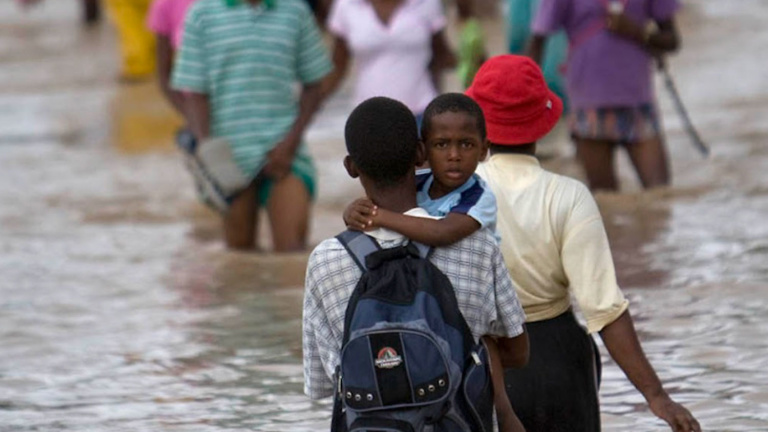
Intergovernmental organisations and climate risks
Intergovernmental organisations (IGOs), such as the United Nations, are increasingly integrating mitigation of climate risks into their mandates. To better understand how IGOs can address climate risks in ways that are just, legitimate and effective, we need to know more about the multilevel nature and (il-)legitimacy of global climate policies.
A challenge shared by all
Climate change, through both its gradual impacts on ecosystems and extreme weather events, poses an entirely new class of risks for humans, communities and states. Many societal threats, such as hunger, vector-borne diseases and loss of housing and shelter, are “multiplied” by climate change and variability.
Since the notion of climate-related security risk emerged in 2007, our emphasis has changed from a narrow focus on state security to a broader perspective including human security (Mobjörk et al. 2016). Climate change threatens human security by undermining the capacities of individuals and their communities to manage, reduce or prevent hazards related to sudden or chronic climate events. Regarding state security, effective climate management is vital to safeguard national sovereignty, military strength and power in the international system.
Climate risks are transboundary in nature, and therefore not amenable to resolution by national governments acting on their own. To address climate risks, states have increasingly relied on IGOs, such as the European Union, the Global Environment Facility, the United Nations Environment Programme (UN Environment) and the World Health Organization (WHO). Through instruments such as project funding, idea diffusion, social shaming and information provision, IGOs can take actions independently of member states and fundamentally influence climate change adaptation at the global, national, subnational and local levels.
A complex and polycentric environmental governance landscape
These IGOs operate in an increasingly complex and polycentric landscape of environmental governance. In it, various forms of transnational hybrid institutions have become active: the Red Cross, transnational private arrangements such as the Marine Stewardship Council, and non-state actors such as the Bill and Melinda Gates Foundation. Like IGOs, they have assumed more prominent roles in the governing of global climate concerns.
Of the approximately 200 existing IGOs, more than 50 engage in climate risk governance. Many of these IGOs are increasingly integrating climate issues into their mandates, even though most were not established with climate issues in mind. For example, the UN Security Council has acknowledged that climate change may exacerbate conflict. WHO has initiated a number of prominent climate-health projects, and the UN High Commissioner for Refugees (UNHCR) has sought to address climate-induced displacement of people by participating in talks under the UN Framework Convention on Climate Change (UNFCCC).
This trend raises important questions about the usefulness of integrated governance. Should climate issues be integrated into global conflict-prevention programmes, despite mixed scientific evidence on climate impacts on conflict? Should the Sustainable Development Goals (SDGs), and global development programmes more broadly, integrate climate issues, or would this crowd out other important development topics such as violence against girls, women and LGBT+ persons? Should the UN Security Council deal with climate change, as it has expertise in coordinating policies among a large number of national governments and can reach fast decisions? Or might this inappropriately shift the focus on state security away from human security? To what degree should IGOs with mandates in policy areas as varied as environment, health and security work together to address climate change?
These questions are fiercely debated among researchers and practitioners. Policymakers depend on scientific evidence and interactions at the science–policy interface for good policy solutions. But scientists seldom have clear answers. Recommendations about how IGOs should integrate climate issues into their mandates are often case-specific and rarely based on generic predictions about the impact of policies on climate-change adaptation (Dellmuth et al. 2018).
Two challenges for adaptation research and practice
In view of existing knowledge gaps, I want to highlight two specific challenges for climate change adaptation research and practice. First, climate change adaptation efforts span different levels of government. While it is analytically useful to distinguish between the local, subnational, national and global governance levels, these levels are in practice interrelated and overlapping. Thus, integrated climate governance has “multilevel” impacts. A UN Environment project on food security can impact global, national, subnational and local efforts to adapt to climate change. Conversely, climate change adaptation efforts of local communities can lead to the “upload” of ideas to the subnational, national and global levels. We need to better understand such multilevel impacts of IGO climate policies.
Second, the legitimacy of IGOs has consequences for their effectiveness in promoting climate security. Legitimacy refers to beliefs among the subjects of a political institution that the institution’s authority is appropriately exercised. Different audiences, such as civil society organisations, politicians, public officials and ordinary citizens, will varyingly believe in the legitimacy of IGOs. A legitimate institution enjoys public confidence, which can increase compliance with the rules it proposes and reduce the need to invest scarce resources in coercion and enforcement. For example, greater institutional legitimacy can diminish the need for imposing and enforcing fines and sanctions. This calls for more social science research on the legitimacy of IGOs’ addressing climate risks, to better understand their varying effectiveness.
Taken together, IGOs’ climate policies are consequential for climate change adaptation efforts across all levels of governance. To understand how IGOs can better address climate risks in just, legitimate and effective ways, we need to know more about the causes and consequences of multilevel and (il-)legitimate climate policies. Social scientists can make a fundamental contribution in enhancing our knowledge on these issues, to assist policymakers in crafting more effective policy solutions to climate risks.
References and further reading
Adger, N. et al. (2014). “Human security”. In C. B. Field et al. (eds), Climate change 2014: Impacts, adaptation, and vulnerability (pp. 755-791). Cambridge and New York: Cambridge University Press.
Dellmuth, L. M. et al. (2018). “Intergovernmental organizations and climate security: Advancing the research agenda”, WIREs Climate Change 9:e496.
IPCC (2018). “Summary for policymakers”. In V. Masson-Delmotte et al. (eds), Global warming of 1.5°C: An IPCC special report on the impacts of global warming of 1.5°C above pre-industrial levels and related global greenhouse gas emission pathways, in the context of strengthening the global response to the threat of climate change, sustainable development, and efforts to eradicate poverty. Geneva: Intergovernmental Panel on Climate Change.
Mobjörk, M. et al. (2016). Climate-related security risks: Towards an integrated approach Stockholm: Stockholm International Peace Research Institute and Stockholm University.
About the author
Lisa Maria Dellmuth is Associate Professor of International Relations at Stockholm University, Sweden, and principal investigator of the five-year research project “Glocalizing Climate Governance: The Role of Integrated Governance for a Just and Legitimate Adaptation to Climate Risks” (GlocalClim) (www.ekohist.su.se/glocalclim).
Read the full magazine issue









